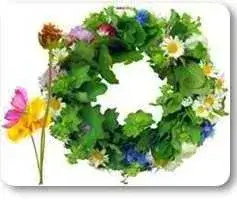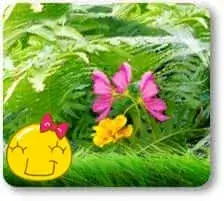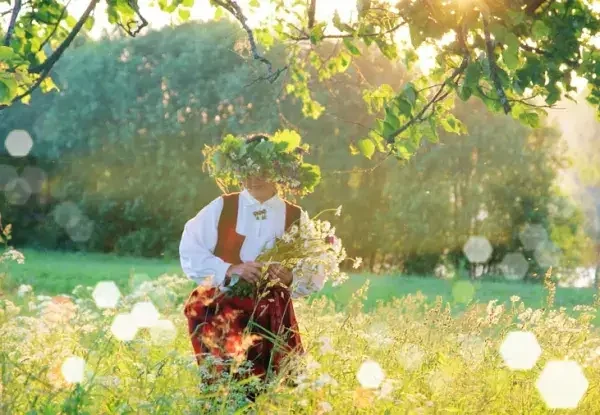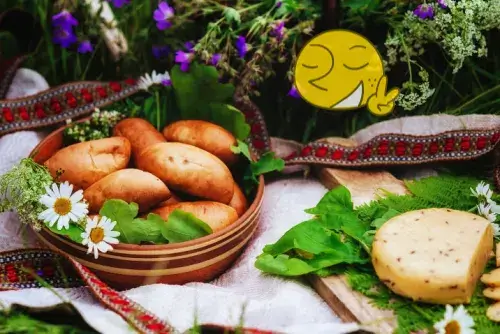Līgo. In Latvia, the summer solstice celebration is a deeply cherished tradition, known as Līgo and Jāņi. It’s a time when magic fills the air, mingling with the scent of wildflowers and the sounds of joyous songs.
More than just a holiday, Līgo and Jāņi represent centuries-old customs, rituals, and a profound sense of community that captivates hearts year after year.
Līgo, The Enduring Power of Ancient Traditions and the Joy of Celebration
As the longest day and shortest night of the year approach, a common question arises: should one celebrate Līgo and Jāņi in the familiar urban setting or escape the city’s hustle and bustle for a more authentic experience amidst nature?
Regardless of the choice, one thing is certain: Līgo and Jāņi will pass quickly, but their most joyful and heartfelt moments will linger in memory, warming hearts during the colder months.
These celebrations are a testament to the enduring power of ancient traditions, offering a unique blend of historical reverence and contemporary joy.
Līgo and Jāņi, Glimpse into the Repository of Līgo Traditions.
This guide aims to provide insights and traditional beliefs related to Jāņi, offering fresh ideas and inspiration for a truly memorable and enriching Līgo and Jāņi celebration, replete with ancient customs.
The Summer Solstice, A Time of Potent Energy.
Jāņi celebrations are intricately linked to the summer solstice, the moment when the Sun reaches its highest point in the sky, marking the longest day and shortest night of the year.
This period in the natural cycle is imbued with a special energy that has inspired people for millennia to celebrate life, fertility, and the power of nature. Jāņi is not merely a holiday; it’s a ritual that connects us with our ancestors and the Earth’s cycles.
It’s a time to acknowledge our place within the grand tapestry of nature and to honor the rhythms that govern our world. The traditions observed during this time are not arbitrary; they are deeply rooted in an understanding of the Earth’s vitality and our dependence on its cycles.
Zāļu Diena (Herb Day) and the Weaving of Wreaths.
June 23rd is Zāļu Diena, a day when people across Latvia venture into meadows, forests, and gardens to gather Līgo zāles (Līgo herbs and plants). This day is dedicated to collecting greenery, picking flowers, and weaving wreaths.
As evening descends, Jāņu vakars (Jāņi Eve) begins, transitioning into Jāņu nakts (Jāņi Night)—the most magical night of the year—and concluding with Jāņu diena (Jāņi Day) on June 24th.
The Magic of Flowers and the Symbolism of Wreaths.
Latvian folklore holds that flowers picked during the summer solstice are imbued with a special natural magic.
These flowers are not only woven into wreaths but also dried for later use, especially during the chilly autumn evenings, to brew teas that can restore strength and ward off illnesses. This practice highlights a practical aspect of the tradition: utilizing nature’s bounty for well-being.
Wreaths are far more than mere beautiful accessories; they are potent symbols of protection and fertility.
Therefore, wreaths should be woven thickly, incorporating as wide a variety of flowers as possible, as each plant possesses its own unique meaning and power:
• Oak (Ozols) will bestow strength, endurance, and health upon Jānis (a common Latvian male name, significant for the holiday) and all men. The oak, a symbol of longevity and resilience, represents masculine power and the steadfastness required for a bountiful harvest.
• Rowan (Pīlādzis), along with “thorny” plants like nettles (nātres) and thistles (dadži), will protect against evil, envy, and negative thoughts. These plants are believed to possess apotropaic qualities, safeguarding individuals and homes from malevolent influences.
• St. John’s Wort (Asinszāle) will provide health and guard against diseases. This herb is widely recognized for its medicinal properties and is associated with healing and vitality.
• Peppermint (Piparmētra) will not only smell pleasant and have a calming effect but also protect against adversaries. Its refreshing aroma is believed to clear the air of negativity and invite positive energies.
• Clover (Āboliņš) symbolizes loyalty, love, and family happiness. The three-leaf clover, in particular, is often associated with the Holy Trinity in some traditions, adding a layer of spiritual significance to its symbolism of unity and good fortune.
• You can also weave wild strawberry vines with their berries into wreaths, which will give the wreath a unique design and additional symbolism of fertility. The inclusion of berries further emphasizes the theme of abundance and the promise of new life.
Preparing for the Festivities.
Preparations for Līgo are undertaken diligently, as tradition dictates that a tidy homestead and completed tasks promote prosperity and blessings.
Field work must be finished, gardens and flowerbeds weeded, and the homestead tidied. Hostesses traditionally prepare cheese, an indispensable part of the Jāņi table, while hosts brew beer from barley, the quintessential Jāņi night beverage.
These preparations are an integral part of the ritual, symbolizing a shedding of the old and an embrace of new energy. It’s a period of collective effort, where every member of the community contributes to the festive atmosphere, reinforcing bonds and shared purpose.
The Magic of Jāņi Night.
A Vigil of Light and Life.
It is well-known that one must not sleep on Jāņi Night. It is a vigil dedicated to watching the bonfire, singing, dancing, and performing rituals.
All activities take place outdoors and revolve around a large bonfire, the very heart of Jāņi Night. The bonfire symbolizes the power of the sun, purification, and light. Its flames are believed to cleanse away negativity and bring warmth and good fortune.
Girls gather flowers in the meadows, weaving and adorning their heads with wreaths, while men named Jānis receive a lush oak leaf wreath as a gift, symbolizing strength and masculinity. The exchange of wreaths is a beautiful gesture, signifying honor, protection, and the interconnectedness of the community.
Jāņu Zāles (Jāņi Herbs) and the Fern Blossom: Symbols of Protection and Mystery.
Jāņu zāles refers to all green plants gathered on Jāņi Day and Jāņi Eve. The most frequently mentioned in folk songs are bedstraw (madaras), mugwort (vībotnes), clover (āboliņš), and cow parsley (buldurjānis).
These plants are not only beautiful but also possess magical properties. They were traditionally scattered in courtyards, cowsheds, and along paths frequented by the household to protect the home and livestock from evil. The practice of scattering herbs is rooted in ancient beliefs about their protective and purifying powers.
Herbs were placed in beds, and tucked into walls and ceilings to ensure health and well-being. Chopped leaves and crushed calamus were sprinkled on the floor, creating a pleasant aroma and a purifying atmosphere. This meticulous attention to the placement of herbs underscores their perceived importance in safeguarding the household.
The fern blossom (papardes zieds) is one of the most my sterious and coveted symbols of Jāņi Night.
Legend has it that it can only be found by those who seek it with their fated beloved, symbolizing deep love, fertility, and luck.
The search for the fern blossom has become a metaphor for the quest for love and destiny on Jāņi Night, adding an element of romantic adventure to the celebrations. It’s a powerful narrative that encourages couples to explore the depths of their connection.
Jāņu Songs and Their Playful Spirit.
Jāņi is unimaginable without songs that reflect the wisdom, values, and humor of the people. These are prayers, wishes, expressions of gratitude, and warnings passed down from generation to generation.
The songs, often imbued with playful teasing (nerātnības dziesmas), especially between men and women, add a lighthearted and interactive dimension to the festivities. They serve not only as entertainment but also as a means of transmitting cultural knowledge and reinforcing social bonds.
These songs are a living testament to the vivacity and resilience of Latvian culture.
Happy Līgo and Jāņi!
May this Jāņi be filled with joy, laughter, delicious cheese and beer, and a deep connection to our ancient traditions. May the bonfires burn brightly, wreaths adorn heads, and the fern blossom bring luck and love! Enjoy this magical time, honoring nature and its power, and surrender to the enchantment of the festivities! Līgo, Līgo, Līgo!
Reflecting on the Enduring Appeal of Jāņi.
Why do these ancient traditions continue to resonate so strongly in modern times? Perhaps it’s the innate human need to connect with something larger than ourselves, to feel part of a continuous narrative that stretches back through generations.
In an increasingly digital world, the hands-on, community-driven nature of Jāņi offers a vital counterpoint, a chance to ground ourselves in tangible experiences and shared heritage.
• Community Building: Jāņi is a powerful force for bringing people together. From the collective gathering of herbs to the shared meals and bonfires, these activities foster a strong sense of belonging and mutual support. How do you see the communal aspects of Jāņi differing from other modern celebrations?
• Connection to Nature: The emphasis on nature—its cycles, its bounty, its magic—is central to Jāņi. This connection provides a vital reminder of our relationship with the environment and the importance of respecting its rhythms. In what ways do you think modern life could benefit from a deeper connection to natural cycles, as exemplified by Jāņi?
• Cultural Identity: For Latvians, Jāņi is a cornerstone of their cultural identity, a vibrant expression of their unique heritage. It ensures that the wisdom and practices of ancestors are not forgotten but are actively lived and passed on. What role do you think such deeply rooted cultural celebrations play in maintaining a sense of national or ethnic identity in a globalized world?
By participating in Jāņi, we not only honor the past but also actively shape the future of these cherished traditions, ensuring their magic endures for generations to come.
Līgo, Līgo, Līgo!




